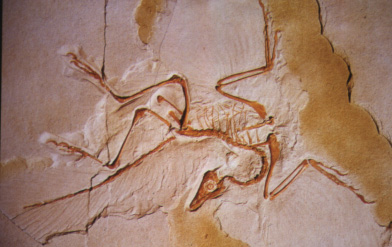Death throes

Dinosaur and pterosaur skeletons are often found in this characteristic posture: head thrown back, hind limbs bent, tail extended. The “dead dinosaur posture” is found in other fossils too—the best known being the fossil bird Archaeopteryx shown here. There are so many fossils found in this posture that a recent article in New Scientist said there are “Too many, in fact, to be a coincidence.”1
This is not news to paleontologists. The question of why so many fossils exhibit this posture “has troubled paleontologists for more than a century”.1 In his 1927 book on taphonomy (i.e. how dead organisms are thought to have been buried and fossilized), German geologist Yohannes Weigelt suggested that the “dead dinosaur posture” was caused by the contraction of the tendons as the dead animal dries out. Others have proposed “diving into mud and becoming stuck”, dying while asleep, rigor mortis, dehydration in salt water, and being dragged into position by moving water.
But to paleontologist Cynthia Marshall Faux, of the Museum of the Rockies in Montana, USA, none of these ideas rang true. Marshall Faux had spent many hours as a volunteer veterinarian at the Montana Raptor Conservation Center, working to save the lives of injured birds of prey. Not all of the injured birds survived, which meant that Marshall Faux had lots of hands-on dealings with dead and dying birds—something that other paleontologists had not experienced for themselves. So she could see that the paleontology fraternity’s attempts to explain the widespread “dead dinosaur posture” did not fit with reality.
“I’d read in the literature about rigor mortis, tendons drying out and all, but it didn’t mesh with what I know from my experience as a vet. Dead bodies moving? That didn’t make sense.” Instead, Marshall Faux knew that animals dying from being poisoned or hit by a car often adopt the posture while still (barely) alive.

Reality check
Marshall Faux decided to put the various death-pose theories to rigorous testing.
- She observed freshly dead birds going into rigor mortis and out of it again—but “never once” did they move.
- She tried drying out carcasses to see if their withering muscles, tendons and ligaments contorted their limbs. The carcasses dried out—but no movement at all.
- After an experiment where rapidly-dried tendons did not contract at all, Marshall Faux said that if a drying tendon cannot even dislodge a small pin from a Styrofoam sheet, it’s hard to picture it moving a dinosaur’s head!
- To test the “dehydration by salt water” theory, Marshall Faux put quail carcasses in buckets of salt water. The dead quails “steadfastly refused to sink”2 and had not changed their posture by the time that the buckets had accumulated “excessive bacterial overgrowth” and had to be thrown out.
As for the other theories, Marshall Faux and her paleontologist colleague Kevin Padian of the University of California ruled out dying while asleep, as “no known animal sleeps in that posture”.1,3 And the suggestion that carcasses were dragged into that position by moving water doesn’t fit with certain fossils having a death pose with neck and limbs pointing in opposite directions—unlikely in fast-moving currents. Further, Padian and Marshall Faux wonder how plausible is it that creatures around the world dived into mud and became stuck?
So for Marshall Faux there’s only one possible explanation: death throes. She and other vets affirm that animals go into the “opisthotonic posture” shortly before they die (not after) because of muscle spasms resulting from severe malfunction of the central nervous system. In short, a shortage of oxygen. So, what might have caused the asphyxiation of the many fossilized creatures beautifully preserved in the “dead dinosaur posture”?
A world drowned
Although Marshall Faux and Padian might not want to acknowledge it, the Bible speaks of a catastrophic event—on a global scale—which simply explains the dying pose of so many of the fossils they have studied. The Flood of Noah’s day was utterly devastating, as “everything on dry land that had the breath of life in its nostrils died”, i.e. “men and animals and the creatures that move along the ground and the birds of the air” (Genesis 7:22–23).
The final agonized death throes of some of those creatures can still be seen today—a testament to rapid burial under muddy layers of now-hardened sediment which thwarted bacterial decay and predators. Surely an unmistakeable legacy that people everywhere would do well to ponder (Luke 17:26–30 , 2 Peter 3:3–7,15 ).
References and notes
- Lawton, G., The big sleep—Why are dinosaurs always found in the same position? There was only one way to find out … , New Scientist 196(2635/2636): 62–63, 22/29 December 2007. Return to text.
- It’s actually very uncommon that dead animals will sink—they generally float on the surface—raising the question of how so many fossilized creatures could have been so beautifully preserved. See Walker, T., Whale explodes fossil theory, Creation 24(2): 25–27, 2002; creation.com/explodewhale. Return to text.
- Marshall Faux, C. and Padian, K., The opisthotonic posture of vertebrate skeletons: post-mortem contraction or death throes? Paleobiology 33(2):201–226, 2007. Return to text.







Readers’ comments
Comments are automatically closed 14 days after publication.